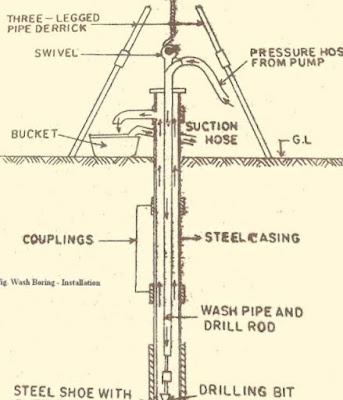Definition of Soil Exploration➪
➱Many aspects , choice of foundation, settlement analysis of soil, the bearing capacity of soil and all other properties depends on various engineering properties of soil.
these properties are to be determined by some field as well as the laboratory test . So, the here in this post,we will discuss mainly on the field test those are conducted to determine these required properties.
What is the purpose of soil exploration ?
What detailed exploration ?.
The primary objective of a soil exploration are-
➱Determination of the nature of the deposit of the soil, depth and the thickness of the each soil layer Strata,
As we know that soil is a layered material . So, what is the thickness of each layer and at what depth it starts and end. all of these the information are necessary for designing a foundation .
➱The Determination of the Engineering properties of the soil and rock strata that affects the performance of the structure.
➱Determination of the in-situ properties by performing field tests.
You must read about The building Construction process and Materials
Soil Strata Required➱
Soil Profile➱
➱The thickness of layer, the soil identification, the starting and the end date of the each layer is also very much important.
Index properties➱
➱water content, atterberg limit etc.
The strength and comprehensibility characteristics-
➱Friction angle(phi), compression index (Cc), OCR (Over Consolidated Ratio).
What is OCR➱
The over consolidated ratio- I have mentioned about the normally consolidated soil and the over consolidated soil . for the over consolidated soil this OCR value is taken as 1. Because in the normally consolidated soil, you have the present stress which is greater than the maximum past stress, which is soil is experienced .
So, here we assume that for the normally consolidated soil, this OCR value is 1, but for the over consolidated soil where the present stress is less than the stress,which the soil is already experienced , here this ratio is the past maximums experience stress of the soil divided by the present stress that we are applying .
So, I have already discussed that how we can determine the maximum past effective overburden stress or maximum past stress, that soil is experienced by casagrande method, we can get that value from e log p curve, and applying the Casagrande method we can determine what is PC . So, that PC is the past maximum effective overburden stress that this soil is experienced.
The ratio between the maximum past stress the soil is experienced and the present stress.
➱Others things (the water table depth),
What are the methods of soil exploration ?
The direct method – test pits➱
➱The test pits or trench are open type or Accessible open type of exploratory method,
➱The soil can be inspected in it’s natural condition.
So, we can Obtain the soil sample from the site itself and those samples we can use to determine the soil properties in the laboratory.
The soil samples can be brought to the laboratory and for determining the properties of the soil.
➱The test pits are suitable up to 3 meters depth(very small depth) and the cost of the this increases proportionally with depth.
➱When The depth of strange is increased, Providing lateral support is must that is why the cost of this is increases with the increase in depth.that is why this method is suitable for sample small depth only up to 3 meter,
What is bituminous layer or Asphalt layer
Semi direct methods – boring➱
➱Boring we have to do, to collect the soil sample for a particular specific depth and those soil sample we use for our laboratory test to determine the soil properties. Sometimes these boring are also required to conduct the field test for a particular depth .
What are the different types of exploration ?.
➱The common methods of boring are
➮Augur boring,
➮wash boring,
➮rotary drilling
➮and percussion drilling .
Auger boring ➱
➱This soil auger(a device) we use for the advancing of a borehole in construction of a bore hole in the ground, it will also use to collect the soil sample and those soil samples we use for the laboratory test.
➱Auger may be hand operated or powered even If it is the hand operated then we can use it for relatively small depth up to 3 to 5 meter. If it is a power driven, then we can use this method up to a greater depth up to 60 to 70 meter in case of continuous light auger. Boring can be done up to 60 to 70 meters if The augur is a power driven augur.
➱Auger boring is easy and useful in case of partially saturated sand silts and medium to steep cohesive soil.
What is Granular Sab base layer (GSB Layers)
Wash boring➱
➱wash boring is generally used below the ground water table for which the auger method is not useful or suitable.
➱This method may be used for all kind of soil except those mixed with gravel and boulder .
➱A casing pipe is pushed and driven into the soil with the help of drop weight;
Rotary drilling➱
➱This is can be used for sand clay and rock (unless this is badly fissured),
➱This is very fast method,
➱Even rock course may be obtained by using a suitable diamond drill bits.
Percussion drilling➱
➱This method cannot be used for loose sand and is slow if this process is low in plastic clay,
➱The formation gets badly disturbed by impact .
What is Consistency test of Cement








